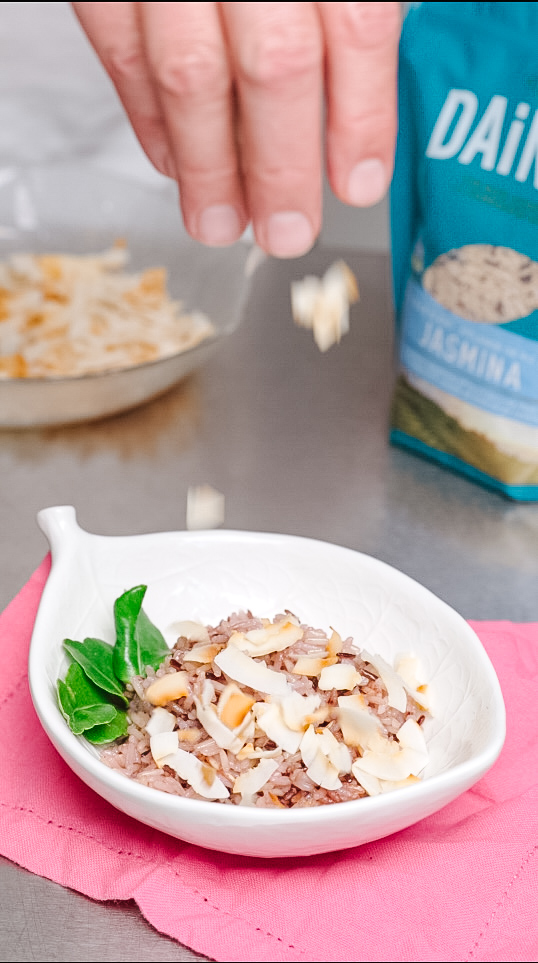This wonderfully fragrant, perfumed and somewhat audacious Greek rice recipe will surprise your guests and family in all the right ways. Read on to find out how to make rice with a twist.
Greek Lemon Rice Pilaf a.k.a Cretan Pilafi

Originating from the famed island of Crete, this Greek Lemon Rice, is a voluptuous perfumed rice dish that delights you with its intense lemon aroma. In Greece, it is considered a popular wedding dish called Gamopilafo – or wedding pilaf. Obviously, there’s no reason not to treat yourself to this scrumptious greek rice recipe at any time.
Indeed, it is such an easy dish to make, and makes a wonderful accompaniment to so many main dishes. Lemon rice pilaf is creamy, succulent, combining the richness of the butter nuanced by the tang of the lemon juice.
With a rice pilaf recipe, uncooked grains of rice need to be toasted in a pan before the liquid – in this case, a chicken broth – is poured over them. Basically, it helps keep the grains from sticking together. Our Greek lemon rice pilaf is perfect served with a rotisserie chicken, or chicken kebabs, or even lamb or shrimp skewers.
How to make Greek Lemon Rice Pilaf
Ingredients and utensils
It is highly recommended to have a tight-fitting lid on your rice pan. This will ensure all the steam is trapped in to help the rice cook evenly.
- 2 tablespoons butter or olive oil
- 1 medium onion, finely diced
- 1 cup long grain rice
- 2 cups chicken broth
- 6 tablespoons lemon juice
- 2 tablespoons chopped parsley
- Lemon zest
- 2 pans, medium and small
- Wooden or silicone spoon
How to prepare our Greek rice recipe
- Take out two pots, one small and one medium. The small pan will serve to heat the chicken broth. The larger pan will be used to cook the rice in.
- Over medium heat, warm the chicken broth in the small pot.
- Add the butter to the second pot, and melt, ensuring it doesn’t burn.
- Stir the rice into the butter and lightly brown it, constantly stirring it with a wooden spoon. You need to achieve a certain level of toastiness, but avoid charring the rice.
- Once the rice is lightly toasted and well basted in butter, pour in the lemon juice. Keep stirring.
- When the chicken broth has warmed, you may start to ladle it to the rice.
- Constant stirring of the rice is essential to a successful recipe.
As the broth is absorbed, add more to the rice until it has been used up entirely. - After absorbing almost all of the chicken broth, remove the pan from the stove.
- Let the lemon rice pilaf rest for about 10 minutes prior to serving.
- Stir the rice one more time before serving, either straight from the pan, or transfered to a serving dish.
- Garnish with chopped parsley and grated lemon zest. Optionally, you may serve with nuts: pistachios, pine nuts, or slivered almonds.
- Smack your lips to this aromatic and delectable recipe.
For those who are very busy
For those who have less time or inclination to keep stirring in front of stoves, an electric rice cooker can also work beautifully .
The cooking steps to this Greek rice recipe are the same . Start by softening the onions, and toasting the rice in butter or oil in a sauté pan.
Then transfer the ingredients to the rice cooker bowl. Proceed, by simply by adding the lemon juice and chicken broth all at once, and turn on the rice cooker Just like the stovetop recipe, after cooking, let the rice sit for about 10 minutes before serving.
As with so many rice recipes, you may find yourself with a bit more than originally expected. Any leftovers can be safely refrigerated for a few days, it’s great for lunch! Once cooked, you may also opt to freeze the rice. In a freezer-safe container, lemon rice pilaf keeps very well for up to 8 weeks.
What is the best type of rice for Greek Lemon Rice Pilaf
For this Greek rice recipe, Dainty Royal Long Grain White Rice is ideal, it absorbs all the flavours and keeps an ideal texture, verging on the slightly sticky, avoiding the full-blown starchiness of some other rices.
In a pinch you could make this recipe with fragrant rices such as jasmine or basmati, but we do think the results are best with a more neutral tasting rice like the long grain rice. The long grain rice avoids the mingling of aromas with the already quite noted taste of the lemon juice and zest.
A type of rice to avoid though is a short grain rice, which holds a greater starch content, resulting in a stickier dish. This Greek rice recipe calls for a balance between the inherent “sauciness” and the lemon juice and broth, and the need to keep the grains of rice nice and loose.









Leave a Reply